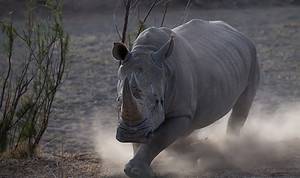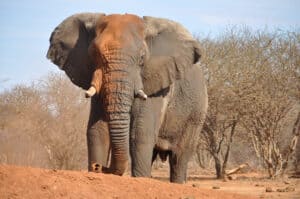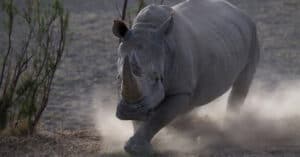In this hilarious footage, a baby rhino cannot make up its mind about which safari jeep he wants to interact with more! He starts by trying to butt and chase after one jeep. Then, he spots another one and races off to do the same to that. Soon he rushes back to the original jeep and spends the next few minutes running between the two vehicles. Meanwhile, an adult rhino (presumably the mom) continues to graze by the roadside and ignores the youngster’s antics!
Watch the Fierce Baby Rhino in Action
What Are the Life Stages of Rhinos?
Female rhinos can reproduce from about five years of age. Their estrus cycle is about 30 days and their pregnancies last for around 16 months. Females have their first calves when they are around six or seven years of age. Mother rhinos have just one calf and give birth every two or three years.
Within three days after birth, baby rhinos are standing and walking around. They live off their mother’s milk but start to eat grass within a month. However, rhino calves continue to nurse from the mother occasionally until they are about a year old. Calves do not leave their mother until they are about two or three years by which time she has another new calf to look after. Female rhinos reach sexual maturity at around seven years of age and males at around 10 or 12 years of age.
What Do Rhinos Normally Eat?
We can see the adult rhino in this clip grazing at the roadside. Rhinos are described as graminivores which means that they live mainly off grass. They have a preference for short grasses and seem to prefer particular species and avoid others. Rhinos do not have incisors so they use their upper lip to grasp grass against their lower lip and rip it from the ground. Using this method, they can eat short grass stalks that are very close to the earth.
Do Rhinos Have Good Eyesight?

Rhinos don’t have great eyesight.
©JONATHAN PLEDGER/Shutterstock.com
Rhinos have quite poor eyesight. However, they can see moving objects better than stationary ones. It’s obvious that their eyes are very small and are positioned at opposite sides of their face with a large snout and horns in between them. This means that there is very little overlap in their field of vision and they have limited forward and three-dimensional vision. To compensate for this, they have good hearing and a great sense of smell!
The photo featured at the top of this post is © Bartosz Budrewicz/Shutterstock.com
Thank you for reading! Have some feedback for us? Contact the AZ Animals editorial team.







